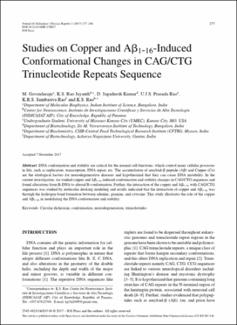| dc.contributor.author | Govindaraju, M | |
| dc.contributor.author | Jayanth, KS Rao | |
| dc.contributor.author | Kumar, D Jagadeesh | |
| dc.contributor.author | Rao, UJS Prasada | |
| dc.contributor.author | Rao, KRS Sambasiva | |
| dc.contributor.author | Rao, KS | |
| dc.date.accessioned | 2020-06-25T01:52:48Z | |
| dc.date.available | 2020-06-25T01:52:48Z | |
| dc.date.issued | 2017-01-01 | |
| dc.identifier.other | 10.3233/ADR-170027 | |
| dc.identifier.uri | http://repositorio-indicasat.org.pa/handle/123456789/110 | |
| dc.description | DNA conformation and stability are critical for the normal cell functions, which control many cellular processes in life, such as replication, transcription, DNA repair, etc. The accumulation of amyloid-β peptide (Aβ) and Copper (Cu) are the etiological factors for neurodegenerative diseases and hypothesized that they can cause DNA instability. In the current investigation, we studied copper and Aβ1-16 induced conformation and stability changes in CAG/CTG sequences and found alterations from B-DNA to altered B-conformation. Further, the interaction of the copper and Aβ1-16 with CAG/CTG sequences was studied by molecular docking modeling and results indicated that the interaction of copper and Aβ1-16 was through the hydrogen bond formation between adenine, guanine, and cytocine. This study illustrates the role of the copper and Aβ1-16 in modulating the DNA conformation and stability. | en_US |
| dc.description.abstract | DNA conformation and stability are critical for the normal cell functions, which control many cellular processes in life, such as replication, transcription, DNA repair, etc. The accumulation of amyloid-β peptide (Aβ) and Copper (Cu) are the etiological factors for neurodegenerative diseases and hypothesized that they can cause DNA instability. In the current investigation, we studied copper and Aβ1-16 induced conformation and stability changes in CAG/CTG sequences and found alterations from B-DNA to altered B-conformation. Further, the interaction of the copper and Aβ1-16 with CAG/CTG sequences was studied by molecular docking modeling and results indicated that the interaction of copper and Aβ1-16 was through the hydrogen bond formation between adenine, guanine, and cytocine. This study illustrates the role of the copper and Aβ1-16 in modulating the DNA conformation and stability. | en_US |
| dc.language.iso | en | en_US |
| dc.subject | Circular dichroism | en_US |
| dc.subject | conformation | en_US |
| dc.subject | neurodegeneration | en_US |
| dc.subject | trinucleotides | en_US |
| dc.title | Studies on Copper and Aβ1-16-Induced Conformational Changes in CAG/CTG Trinucleotide Repeats Sequence | en_US |
| dc.type | Article | en_US |

